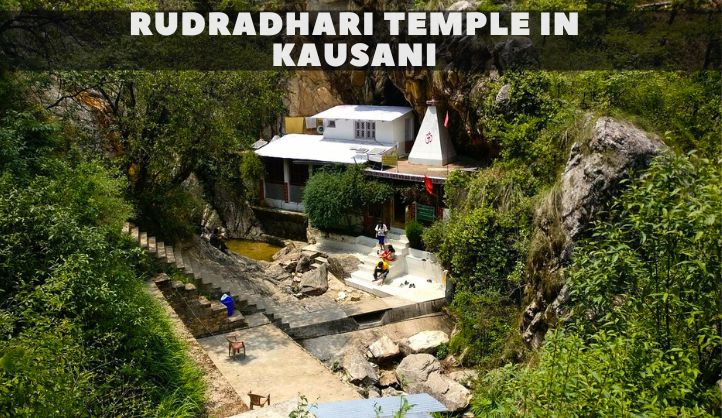Nestled amidst the verdant embrace of the Kumaon Hills in Uttarakhand, India, lies the Rudradhari Temple, a hidden gem veiled in serenity and steeped in mythology. This ancient cave shrine, dedicated to Lord Shiva and Lord Vishnu, beckons adventure seekers and devotees alike, offering a captivating blend of spiritual allure, natural beauty, and a challenging trek through the Himalayan wilderness.
A Journey Through Myth and Legend
The very name “Rudradhari” carries an echo of its legendary past. “Rudra” is another name for Lord Shiva, the Destroyer and the Regenerator, while “Hari” refers to Lord Vishnu, the Preserver. Local lore weaves a tale of these two deities converging at this very spot. According to the legends, Lord Shiva and Lord Vishnu engaged in a cosmic game of dice, and the serene environs of Rudradhari served as their playground.
Another legend narrates the tale of Sage Kashyap, who meditated here for an extended period, seeking divine blessings. The caves surrounding the temple complex are believed to have been his abode. These stories imbue the temple with a mystical aura, attracting pilgrims who seek a deeper connection with the divine.
A Trekker’s Paradise
Reaching the Rudradhari Temple is an adventure in itself. Located approximately 8 kilometers from the hill station of Kausani, the temple requires a trek of about 2 kilometers. The path winds through dense forests, teeming with vibrant flora and fauna. The chirping of birds fills the air, and the gentle murmur of a nearby stream creates a symphony of nature.
The initial ascent involves negotiating a series of stone steps, followed by a more gradual incline through the woods. This section provides ample opportunity to soak in the breathtaking beauty of the Himalayas. Lush green slopes carpeted with wildflowers, towering pine trees reaching for the sky, and the distant peaks painted in hues of blue and purple create a picture-perfect postcard.
The final leg of the trek involves another set of stone steps, leading directly to the temple entrance. While the trek may pose a slight challenge, the rewards are immeasurable. The sense of accomplishment upon reaching the temple, coupled with the breathtaking panorama that unfolds, is truly invigorating.
A Spiritual Haven Carved in Nature
The Rudradhari Temple itself is a captivating sight. Carved into a natural cave formation, the shrine exudes an air of tranquility. The sanctum sanctorum houses a Shiva lingam, the iconic representation of Lord Shiva. The simplicity of the temple’s architecture stands in stark contrast to the grandeur of its natural setting.
Adjacent to the main temple lies a smaller cave, believed to be the meditation chamber of Sage Kashyap. The serenity of this space invites introspection and spiritual reflection. Here, amidst the gentle murmur of the waterfall and the rustling leaves, one can truly find solace and commune with the divine.
Beyond the Temple: Unveiling the Environs
The Rudradhari Temple complex is not limited to the cave shrine. A cascading waterfall, known as Rudradhari Falls, adds to the charm of the location. The gushing water, especially during the monsoon season, creates a mesmerizing spectacle. Visitors can take a refreshing dip in the natural pool formed beneath the falls, adding a touch of rejuvenation to their spiritual pilgrimage.
For the more adventurous, there are possibilities for further exploration. The surrounding hills offer opportunities for short treks, leading to viewpoints that showcase the majestic Himalayan panorama in all its glory.
A Pilgrimage for All
The Rudradhari Temple is a destination that caters to a diverse range of visitors. Devotees seeking spiritual solace find themselves drawn to the temple’s tranquil atmosphere and its association with Lord Shiva and Lord Vishnu.
Nature enthusiasts, on the other hand, are captivated by the challenging trek, the breathtaking scenery, and the abundance of flora and fauna. Adventure seekers relish the opportunity to explore the surrounding hills and discover hidden gems.
Planning Your Pilgrimage
The ideal time to visit the Rudradhari Temple is during the spring season (March to May) or autumn season (September to November). The weather during these periods is pleasant, making the trek more manageable. It’s advisable to avoid the monsoon season (June to August) due to potential landslides and slippery paths.
Since the temple is located in a remote area, carrying essential supplies like water, snacks, and proper hiking gear is crucial. Hiring a local guide familiar with the terrain is highly recommended, especially for first-time visitors.
How to Reach the Rudradhari Temple
While the trek itself is undeniably part of the Rudradhari Temple experience, there are several ways to reach the starting point at Kausani, depending on your preference and travel style.
Taking to the Skies: Arriving by Air
The nearest airport to Rudradhari Temple is Pantnagar Airport (PGH), located approximately 170 kilometers away. From Pantnagar, you can hire a taxi or cab to reach Kausani, the hill station that serves as the base for the trek. This option offers the fastest travel time but might be the most expensive.
A Journey by Road: Reaching Kausani by Car or Bus
For a more budget-friendly option, consider traveling by road. Kausani is well-connected to major cities in Uttarakhand like Dehradun and Haridwar by regular bus services. You can also hire a car or taxi for a more comfortable journey. The drive itself offers scenic beauty, allowing you to soak in the Himalayan foothills.
Train Travel: A Scenic Route with a Catch
Train travel enthusiasts might be disappointed to learn that there’s no railway station directly connected to Kausani. However, the nearest railway station is Kathgodam, situated around 85 kilometers away. From Kathgodam, you’ll need to hire a taxi or car to reach Kausani. While this option adds another leg to your journey, it can be a scenic route offering glimpses of the mountains.
Combining Modes: Tailoring Your Travel
For a more flexible approach, you can combine different modes of transportation. For example, you could take a train to Kathgodam and then hire a taxi to Kausani. This allows you to experience the comfort of train travel while enjoying the convenience of a car for the final leg.
Remember
- Regardless of your chosen mode of transportation, plan your travel well in advance, especially during peak seasons.
- Research and book your accommodation in Kausani beforehand, as options can be limited.
- Consider hiring a local guide familiar with the trek path, especially if you’re a first-time visitor.
By planning your travel effectively, you can ensure a smooth journey to the starting point of your Rudradhari Temple adventure. So, pack your bags, choose your travel mode, and get ready to embark on a captivating journey towards this hidden Himalayan treasure.
Conclusion
The Rudradhari Temple is more than just a building – it’s a chance to explore the mountains, connect with nature, and maybe even learn a little something about yourself. So, if you’re looking for an adventure that will leave you feeling good, this hidden gem in the Himalayas is waiting for you!
FAQs About Rudradhari Temple
Where is the Rudradhari Temple?
The Rudradhari Temple is nestled in the Kumaon Hills of Uttarakhand, India, near the hill station of Kausani.
How difficult is the trek to the temple?
The trek is about 2 kilometers long and involves some initial stairs followed by a gradual incline through the forest. The final leg might be steeper, but the overall difficulty is moderate.
What’s the best time to visit?
Spring (March-May) and autumn (September-November) offer pleasant weather for the trek. Avoid the monsoon season (June-August) due to potential landslides.
How can I reach Kausani, the starting point?
You can fly into Pantnagar Airport and hire a taxi to Kausani. Alternatively, take a bus or hire a car from major Uttarakhand cities like Dehradun or Haridwar. Trains reach Kathgodam, from where you’ll need a taxi to Kausani.
What should I pack for the trip?
Bring essentials like water, snacks, good hiking shoes, and reusable water bottles. Consider hiring a local guide familiar with the area, especially for first-time visitors. Remember to dress modestly when visiting the temple.









